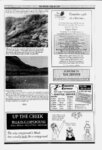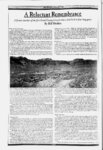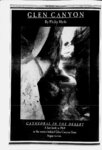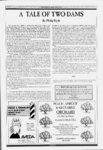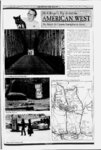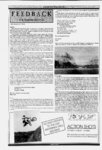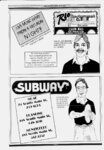| OCR Text |
Show K ...J I'AvXwWvA.yW'Iv; mMW i.mv.vi,iwrfAm,v,.wAVdWisv.vAWAV.,wwvk,AwAwviw.'rfAv1y1y.-AVto4vftiAyArflyrtAy- SPECIAL TWELVE PAGE GLEN CANYON REPORT: WHY WE SHOULD DRAIN LAKE POWELL Thirty-fou- r its time to say: Let's pull the plug By Jim Stiles years after the reservoir began to fill, January 21, 2043. A cold writer wind whipped and buffeted the ten thousand visitors who had made their way from across America and the world to witness this historic event. But no one complained about the add. Crammed into the parking lot of the Carl Hayden Visitor Center at Glen Canyon Dam, few of those present ever dreamed they would live long enough to see this day. After a few opening comments by the Secretary of the Interior and the Governor of Arizona (the Utah delegation chose to boycott the ceremony) the President of the United States rose slowly and walked to the podium... "My fellow Americans, but perhaps more inclusively, my fdlow citizens of this beautiful planet we adl Earth...we join today, all of us, to return something. To right a wrong. To restore a masterpiece. We are gathered here to give a place called Glen Canyon a second life. " Eighty years ago today, at this exact moment, the living Colorado River in Glen Canyon ceased to flow. A switch was thrown, a steel gate was sealed and the slack waters of Lake Powell began to rise behind the enormous concrete dam that stm stands behind us, almost a century later. "The decision to flood Glen Canyon was not made by evil men and women. It was not the work of malevolence. It was, instead, an act of ignorance. And shortsightedness. We could only see kilowatts of power and tourist dollars. We failed to see, at the time, the crime we were committing. "...on behalf of the thousands of once lonely voices who have waited decades for this moment, 1 return Glen Canyon to the world in your honor...! only wish my father could have been here to see this day." With a single command to the central computer, Rebecca Abbey, 50th President of the United States, opened the diversion tunnel gates...Ed would have been proud. said. Hopeless dreams, doomed to failure, somebody once And indeed, the idea that someday, thoughtful, intelligent humans might gather It was a mistake, let's fix it... well, together and say: this dam, this Glen Canyon Dam. not long ago, the idea seemed not only unlikely but ridiculous. The kind of hopeless dream that hopeless dreamers prefer. But is it such an impossible fantasy? If there is a growing consensus that the construction of Glen Canyon Dam was a mistake, and there is, then is it so difficult to imagine us trying to mend the error of our ways? For the first time in 34 years, there are more than just a few voices who are saying, no. The time has come to drain Lake Powell. A Brief History Glen Canyon Dam. Five million cubic yards of concrete located on the Colorado border. Seven hundred and ten feet high. Generating River near the Arizona-Uta- h of a million people. Built at a enough electricity, 1.3 million kilowatts, to serve a city cost of $300 million under the direction of the Bureau of Reclamation's Floyd Dominy. flow of the Colorado River. Impounding 27 million acre feet of water, two years' Creating Lake Powell, a mecca for more than four million tourists every year. The statistics are always impressive and anyone who has ever been to the dam cannot help but be stunned by the sheer size of it. The dam is overwhelming. For a technophobe like myself, someone who has a difficult time with straight lines and VCR instructions, I look at Glen Canyon Dam and ask: How did they know where to start? But somebody did. And almost seven years after construction engineer Lem Wylie hitched a ride upstream with tour boat operator Art Greene to see the dam site close up, the last bucket of cement was poured and, on January 21, 1963, the reservoir began to rise. Why was Glen Canyon Dam built? It generates all cheap electrical power, more than a billion dollars worth since 1964, but that isn't the reason they built the dam. Tourism created by the reservoir is a billion dollar industry, but tourism is only a secondary benefit as well. step-by-st- ep Glen Canyon Dam was built to store water. In November 1922, seven western states California, Arizona, Nevada, Utah, New Mexico, Colorado and Wyoming signed the Colorado River Compact. After years of squabbling over water rights, the feuding states reached an agreement whereby the water of the Colorado River could be fairly distributed. The states were divided into the Upper Basin and the Lower Basin. The dividing line was established at Lee's Ferry, Arizona. The Upper and Lower Basins were each allocated 75 million acre feet of water, based on a rather dubious Bureau of Reclamation study that suggested the annual flow of the river was about 17.5 million acre feet. A million and a half acre feet was promised to Mexico and the rest was to serve as a reserve. California demanded the extra million and they got it. But the flow of the Colorado River is hardly consistent. During drought years, the river can dwindle to a trickle. In other years, when heavy snowfall in the upstream mountains begins to melt, the river can be a torrent. No one wanted to see millions of acre feet flow into the Gulf of California and during drought years no one wanted to be left high and diy. The Upper Basin states needed to be able to store water so they could meet their downstream commitments to the Lower Basin states. For years, BuRec engineers had pushed for a high dam in Glen Canyon, but it had always been passed by, partly because of its remoteness, partly because of the unsuitability of its sandstone walls as a dam site, mostly because there were other sites that always seemed more appealing. In the early 50s, an historic battle took shape between the pro-dabuilding engineers and western politicians and the fledgling conservationists of that time, led by David Brower and the Sierra Club. The story has been told a thousand and one times and it must be painful for Brower to be continually reminded, but the Sierra m coaliimed oi aext page |




